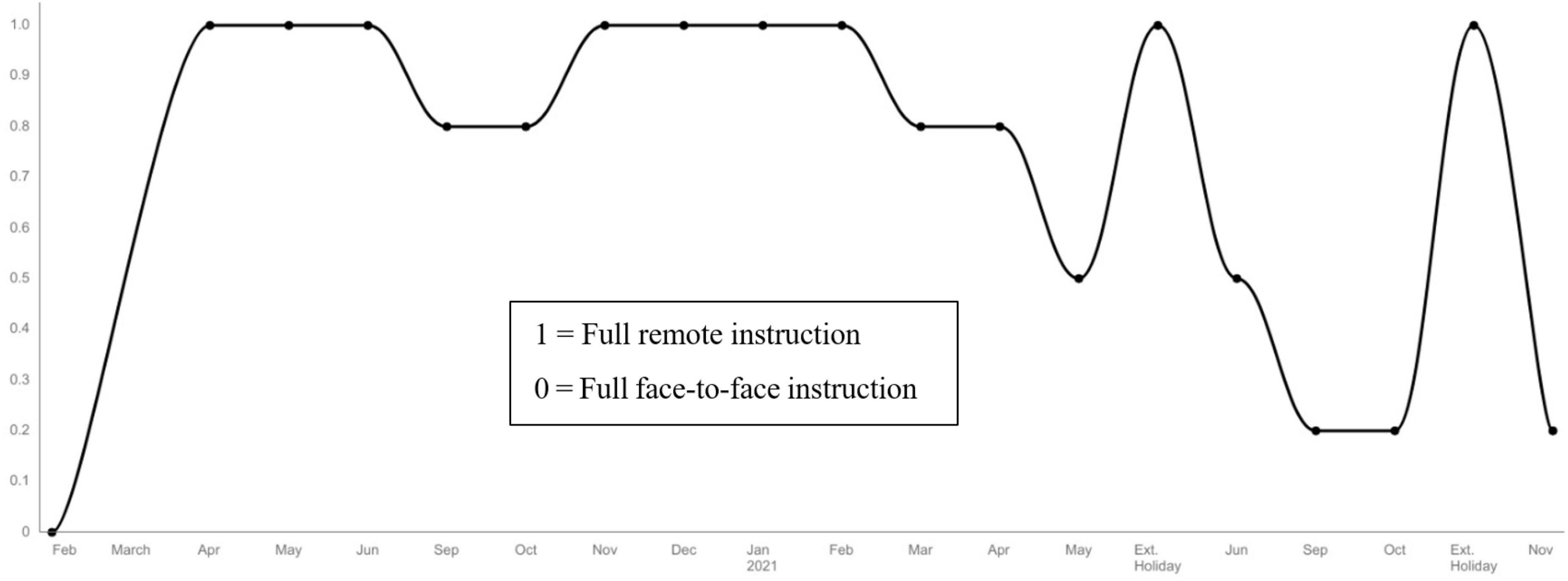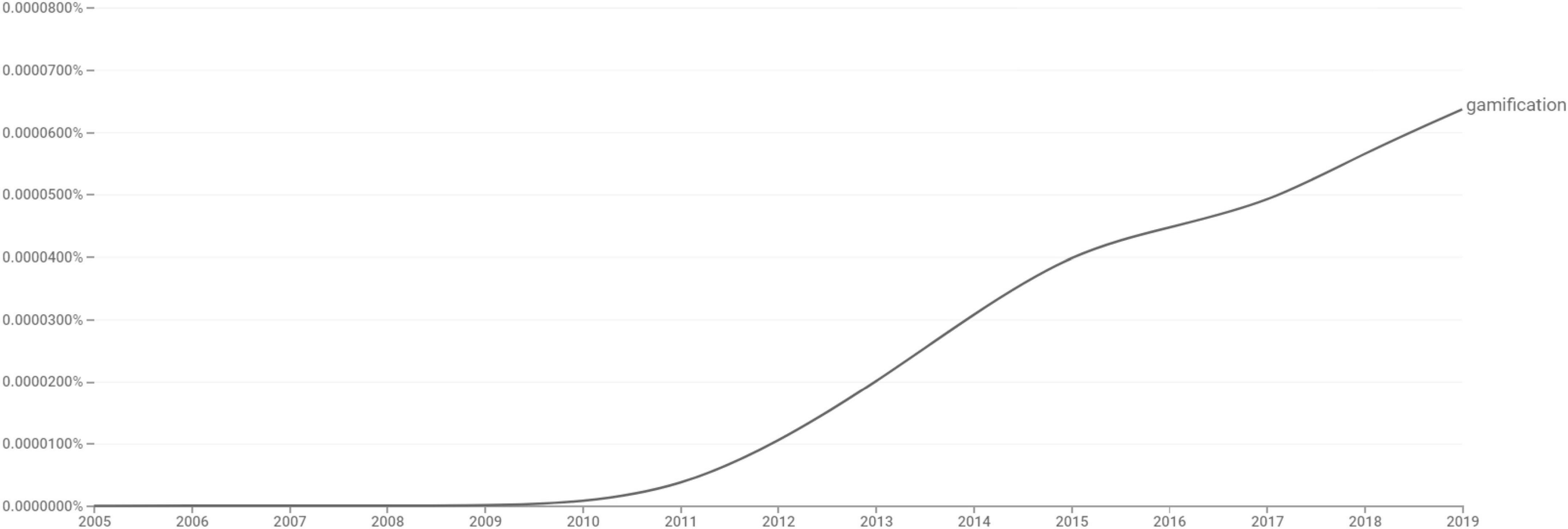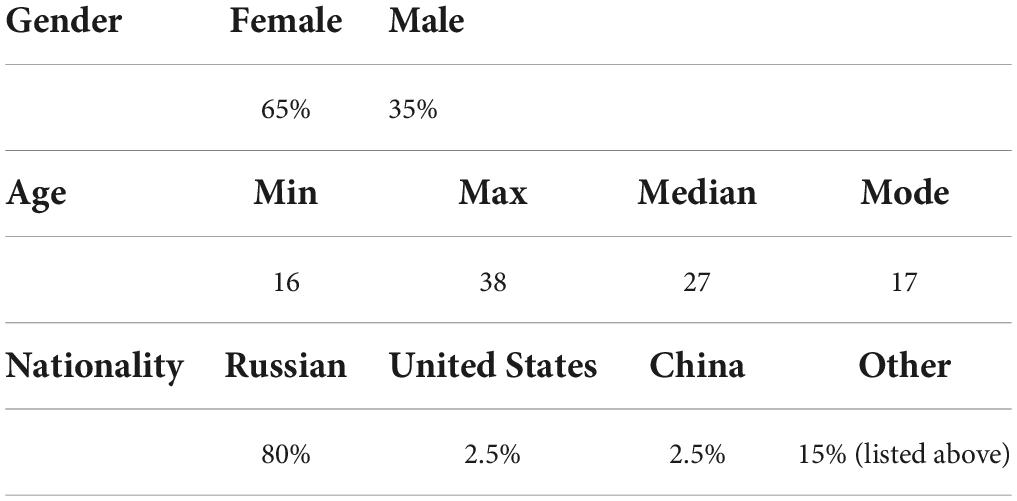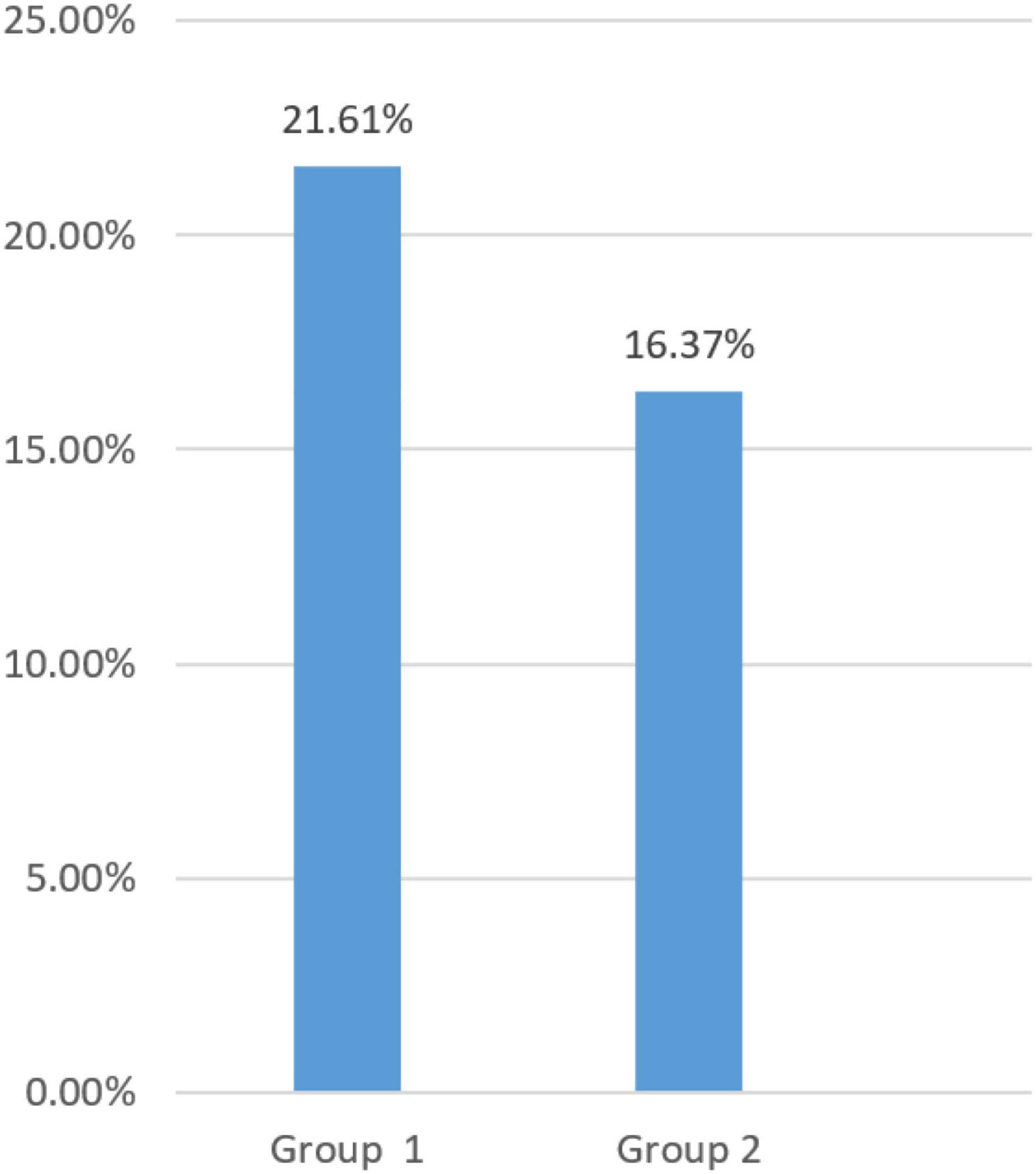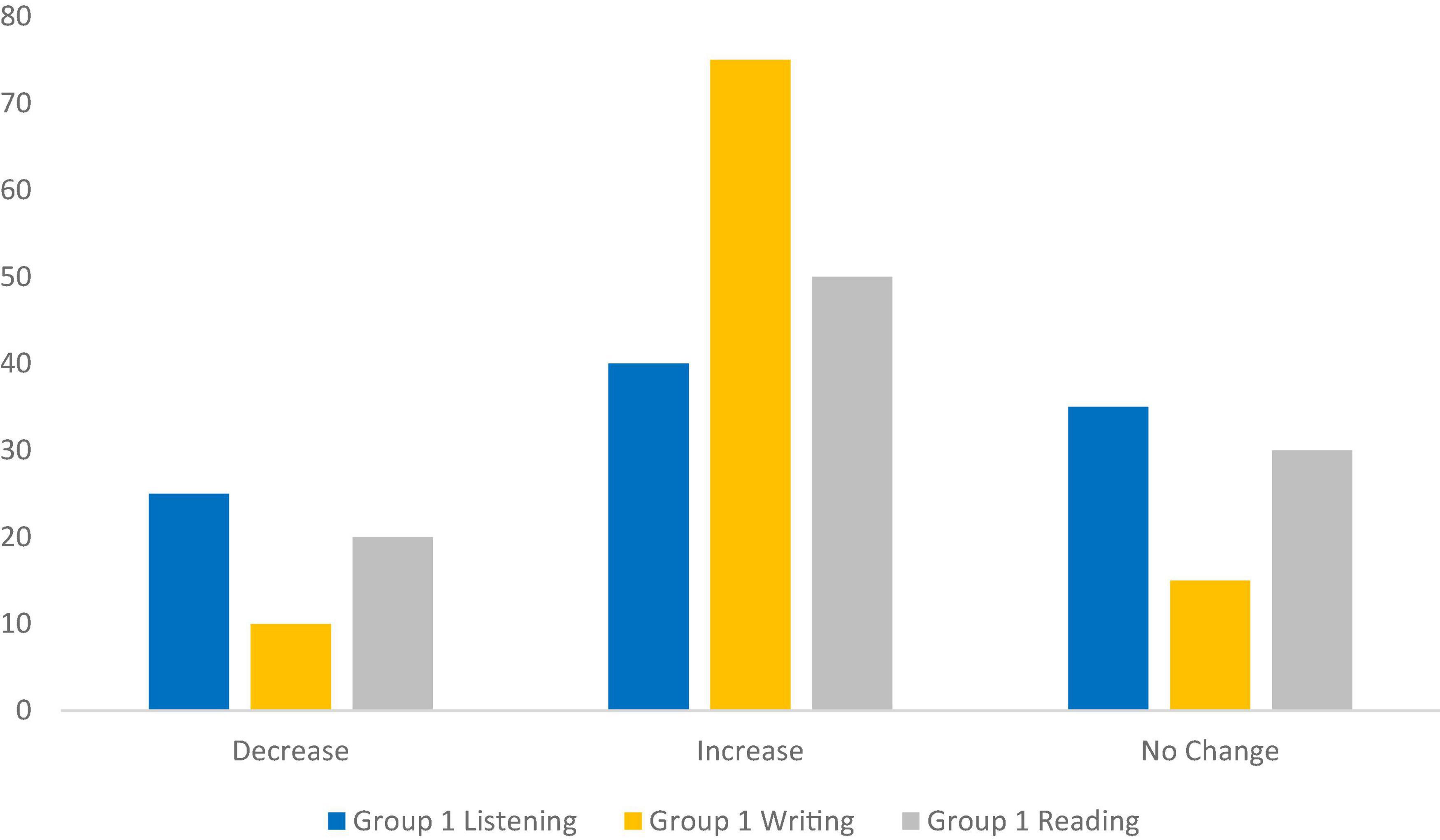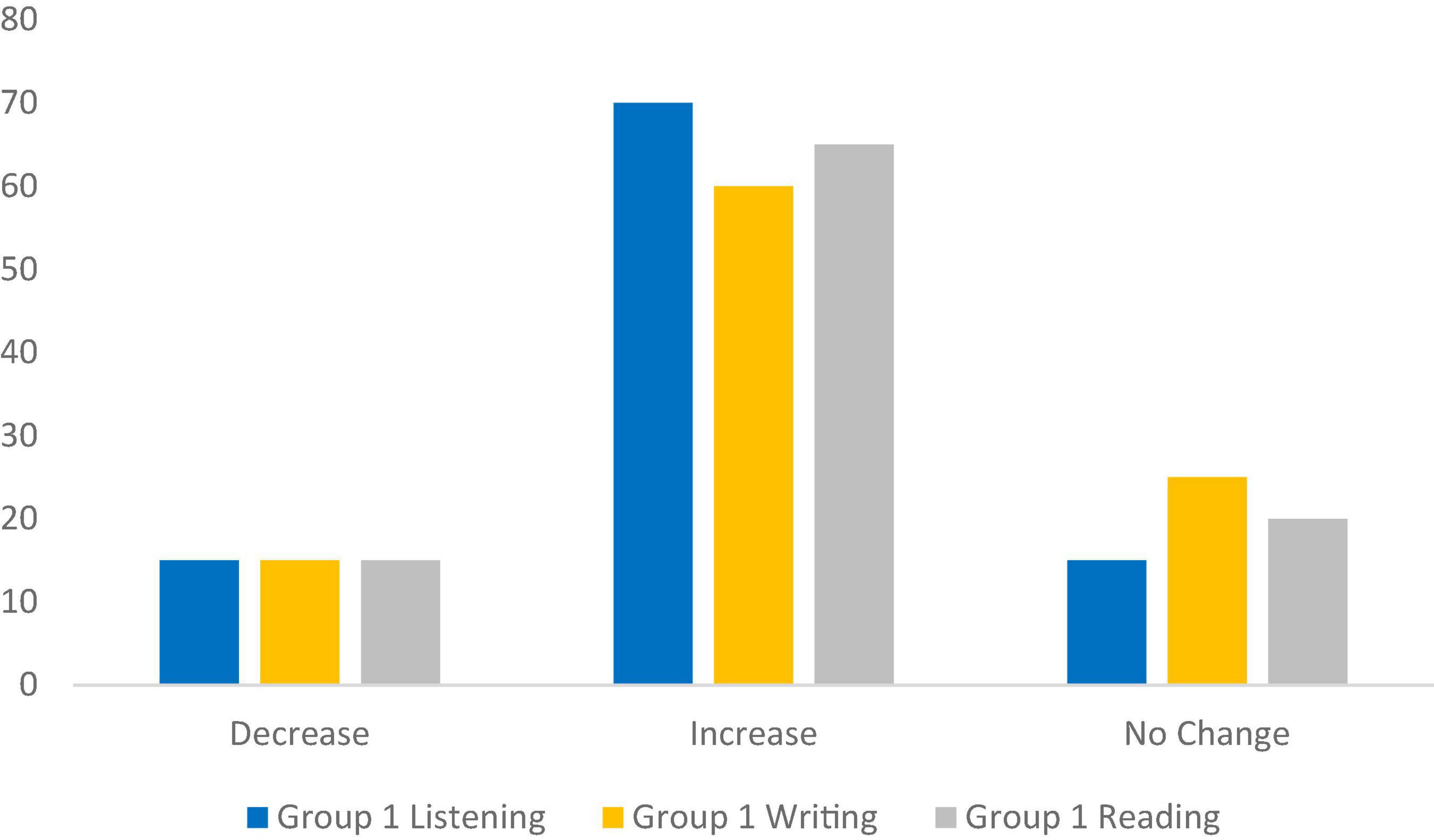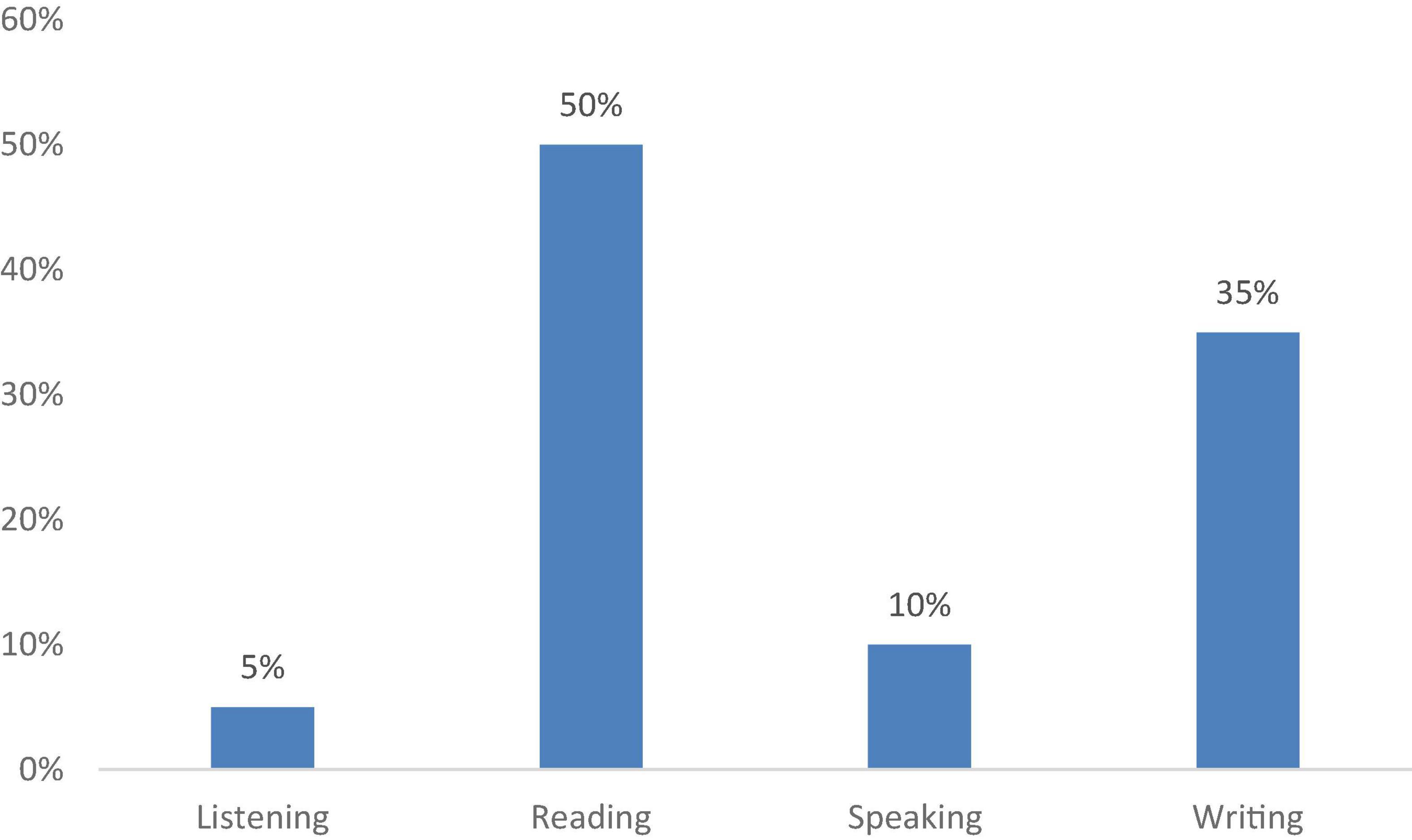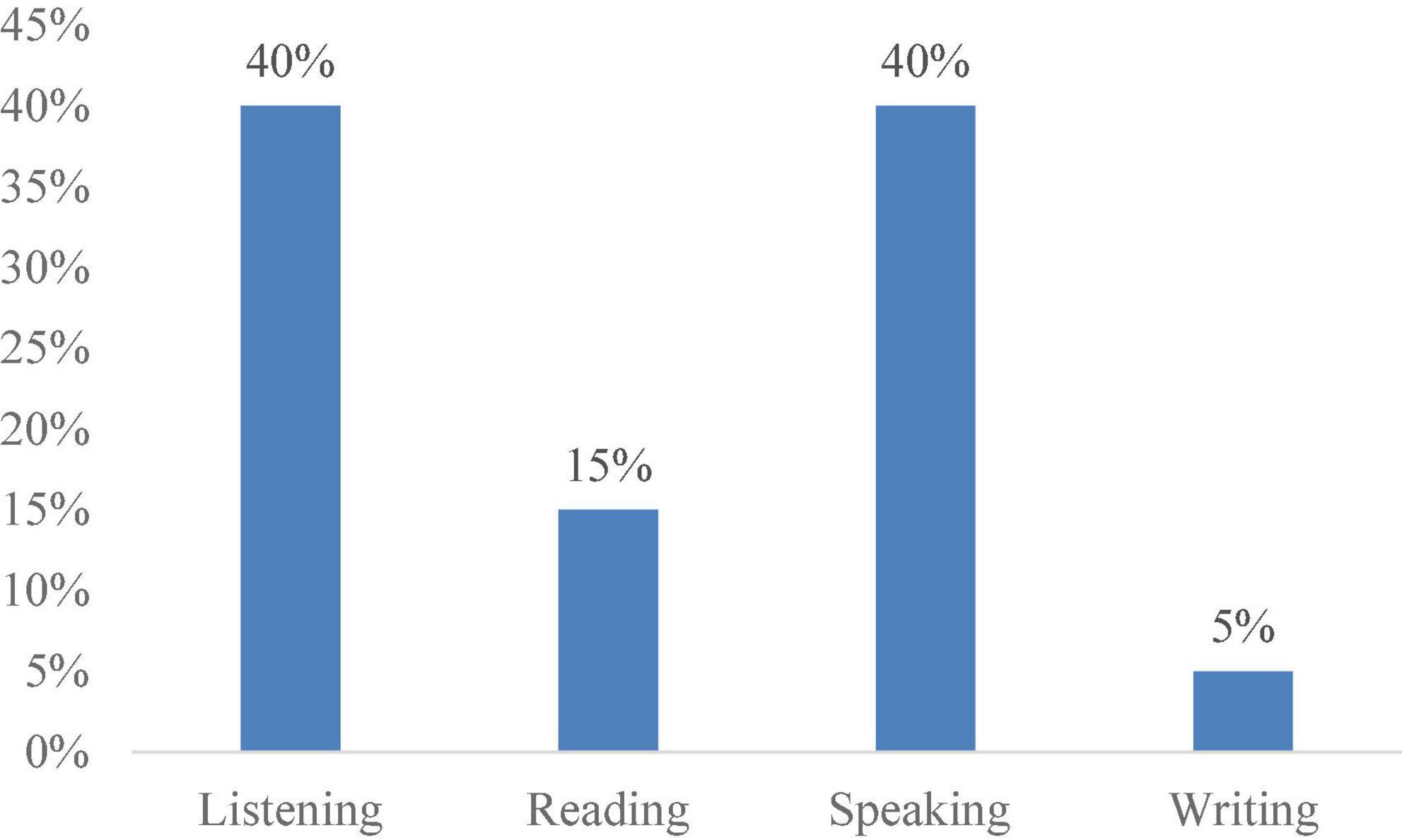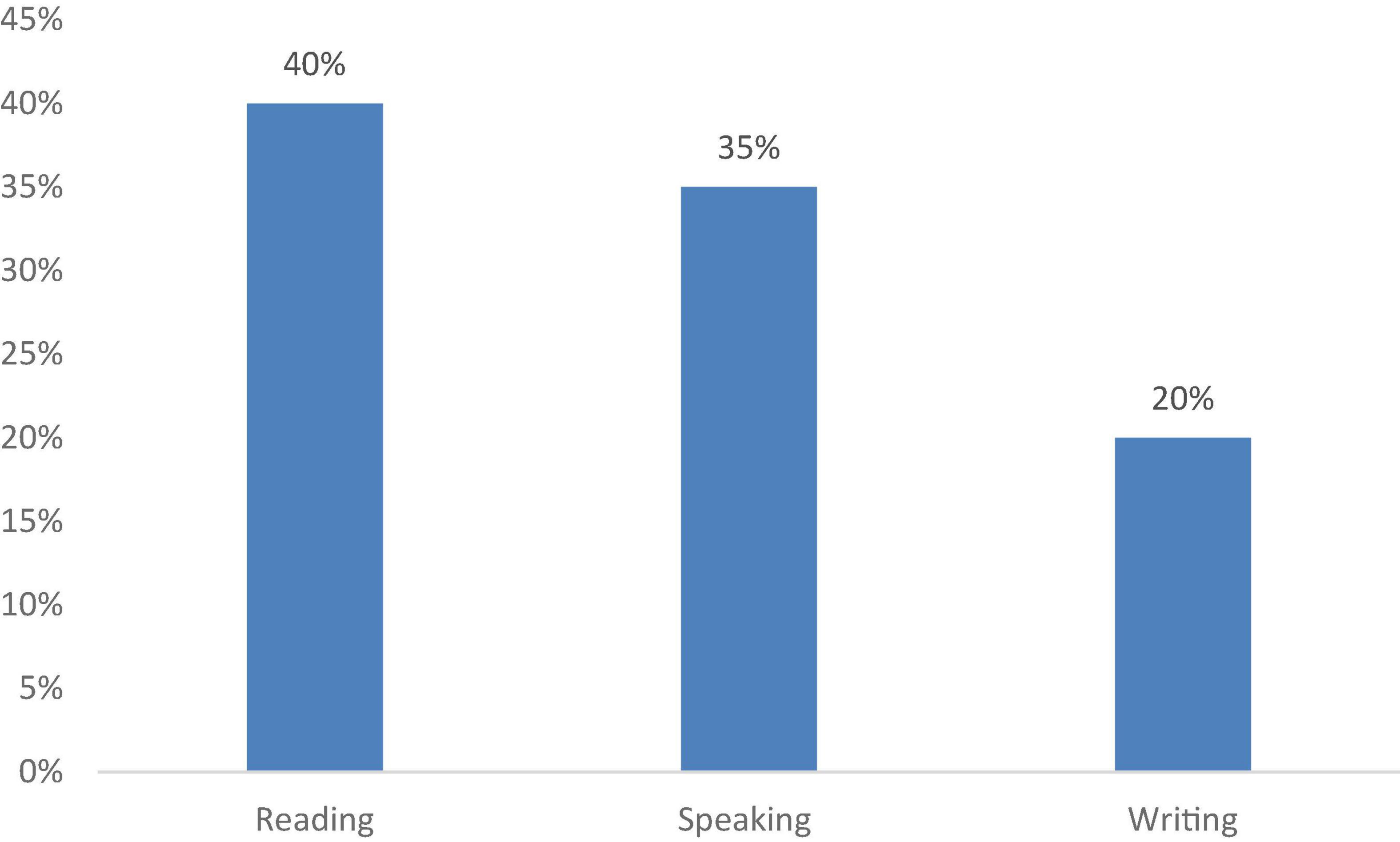The effects of introducing language learning software during the COVID-19 pandemic
- Foreign Languages Department, Law Institute, Peoples’ Friendship University of Russia – RUDN University, Moscow, Russia
The research aimed to investigate the impact of introducing language learning software to university students in the learning environment influenced by COVID-19. It describes the results of an experience with adding daily activities in Elevate, a free language learning application marketed as brain training software for the undergraduate English curriculum. The experiment took place at RUDN University (Moscow, Russia) in 2021 during the COVID-19 pandemic. Participants were engaged in synchronous distance and face-to-face learning, depending on their location and the current epidemiological situation. Some students alternated between online and offline environments. Research methods included a theoretical analysis of current trends in language training and gamification. Statistical data were collected and processed using the university’s digital ecosystem. The research included quantitative data from the experiment and surveys, which consisted of multiple-choice, single-choice, and open-ended questions. The research sample included students from eight countries with the common european framework of reference for languages (CEFR) levels of English from B1 to C1. The research results show the effects of language learning software on students’ language proficiency (P). From the results of this research, it can be concluded that schools and universities can use multi-level feedback from participants to maximize the effectiveness of language training and diversify the range of activities included in the curriculum. The results also provide the theoretical basis for e-learning software development and represent a new contribution to the literature.
Introduction
The outbreak of the COVID-19 pandemic is an event that has significantly changed and is still affecting the learning environment on a global scale. Educational experts and researchers in various fields emphasize the unprecedented multidimensional impact of the closures on numerous aspects of teaching and learning (Subedi and Subedi, 2020; Tarman, 2020; Jaradat and Ajlouni, 2021; Salakhova et al., 2021; Soltovets et al., 2021; Kuzembayeva et al., 2022; Uzunboylu et al., 2022). While it has been noted that educators faced the greatest challenges on a global scale during the forced transition from face-to-face to distance education in the early 2020s, scholars have also emphasized that these events are leading to long-term transformations and reconceptualization of the learning landscape (Burgess and Sievertsen, 2020), with digitization playing an unprecedentedly important role.
The current research focuses on the impact of digitization on the learning environment affected by COVID-19 lockdown. Specifically, it focuses on the potential benefits of using language learning software as an additional tool to improve the foreign language skills of Russian university students. According to data from united nations children’s fund (UNICEF) (Dreesen et al., 2020), the first year of the COVID-19 pandemic has highlighted the importance of the digital divide in educational institutions worldwide. This study analyzes the experience of teaching foreign languages to law students in a mixed environment (combination of distance and face-to-face teaching) at RUDN University, also known as the Peoples’ Friendship University of Russia.
Throughout its history, the university has undergone numerous paradigm shifts caused by changes in the learning landscape while maintaining its focus on internationalization. The latter has been identified as one of the most important characteristics of a modern university, enabling it to gain a foothold in the global education market rather than being limited to the local market. The impact of internationalization is manifold. It allows universities to compete with foreign higher education institutions as destinations for domestic students and domestic institutions offering graduate and postgraduate programs to international students. The widespread availability of learning resources, as well as the current pandemic, has helped some scholars distinguish between “internationalization at home” and “internationalization abroad” (Mittelmeier et al., 2021).
While educators stress the importance of internationalization, they also warn of its potential negative effects and urge international universities to focus on preventing content dilution and maintaining higher standards (De Wit, 2017). One of the ways to solve this problem is to design curricula that meet the requirements of the international labor market, provide relevant content in foreign languages, and contribute to the development of professional skills (Shaidullina et al., 2015; Atabekova, 2021). To achieve this, the university attaches great importance to providing lifelong language training to its students and faculty and maintaining and improving this ability in distance education mode. The lockdown of RUDN University was initiated by the Russian Ministry of Science and Education in March 2020 (Atabekova et al., 2021). Figure 1 below illustrates the approximate timeline of the COVID-19 response.
According to the above data, RUDN University was able to gradually reintroduce face-to-face classes for a select number of students at the beginning of the 2020–2021 academic year, focusing on the adjustment of first-year students while taking the necessary precautions to prevent the further spread of COVID-19. While there was worldwide discussion of the possibility that universities could return to near-normal operations in 2021 (Sleiwah et al., 2020), the course of the pandemic prevented universities from reintroducing full face-to-face classes, many measures (including faculty vaccination) taken in Russia allowed RUDN University to begin the 2021–2022 academic year with face-to-face courses for all students living in Moscow and to change the mode of instruction as needed. As of November 2021, the situation has improved significantly compared to the same period in 2020. Nevertheless, the dynamics show the importance of considering closures in risk management (Beery, 2020) and contingency planning (Ross and DiSalvo, 2020) and implementing long-term solutions for distance education, especially in such skill-based disciplines as foreign language education.
According to the studies conducted during the pandemic (Hazaymeh, 2021; Maican and Cocoradã, 2021), foreign language instruction is particularly sensitive to changes in the mode of instruction. In addition, gamification has been found to improve students’ motivation, referred to as digital natives (Butler, 2015; Kotob and Ibrahim, 2019), encouraging them to participate in concise language practice by introducing tools such as daily achievements. The Elevate application, released in 2014, is classified by its developers as a “brain training app.” However, it can be argued that this categorization is not entirely accurate, as the effects of training on the brain have been questioned by the scientific community, as mentioned earlier, on cognitive abilities (Ng et al., 2020; Stojanoski et al., 2021). The analysis of the activities offered in the application shows that it can be considered a more traditional solution for language training, as it contains the categories of reading, speaking, listening, and writing. In light of this, we conducted a pilot study using the Elevate cell phone software and a set of assessment tools to determine if the skills acquired while using the application are transferable to a mixed learning environment (offline and online) and if the application can be recommended to students as an efficient additional language training tool.
Literature review
The analysis of the current trends in academic research on gamification of language training and its history, conducted using the digital databases of Google Scholar and Elsevier, demonstrates the current popularity of the topic while highlighting the importance of conducting a study that takes into account the specifics of the current situation in the global learning environment. The general trend of digitization in education, as well as the difficulties and benefits associated with it, has been outlined by scholars in several publications (Shaidullina et al., 2018; Sadeghi, 2019; Tarman et al., 2019; Kalimullina et al., 2021; Ivanova et al., 2022). The impact of digitization on education during the pandemic has also highlighted the importance of the “digital divide”; scholars describe it as a well-known but previously underestimated phenomenon (Lai and Widmar, 2021), citing social and motivational issues, accessibility, etc. (Aboagye et al., 2021). The gap above is significant in international higher education institutions and has affected students’ overall perception of the learning process during the pandemic (Budur, 2020).
The difficulties students face have also been described in blended learning studies (Dahmash, 2020; Mahaye, 2020; Sefriani et al., 2021). Although the current generation of students (born after 1980) has been labeled digital natives (Margaryan et al., 2011; Dauzón and Izquierdo, 2020), issues related to digital literacy are still present in this generation. The events of 2020 led to a dramatic increase in the pace and depth with which digitization impacted the global learning landscape, leading some scholars to use the term “shock digitization” (Chigisheva et al., 2021). Scholars also include among the most recent trends in education the increasing popularity of technologies such as virtual reality (Volkova et al., 2020) and augmented reality (Elmqaddem, 2019). While these technologies are well-established in the universal digital landscape, their current use is new and has been shown to enhance learning through gamification (Horváth, 2018).
Scholars describe gamification as design principles, processes, and systems used to influence, engage, and motivate individuals, groups, and communities to promote behaviors and achieve desired outcomes (Huang and Soman, 2013). This process has been associated with increased student motivation (Buckley and Doyle, 2016; Alsawaier, 2018; Chapman and Rich, 2018) and productivity (Gamlo, 2019), as well as minimizing distraction and improving learning curve dynamics (Kayımbaşıoğlu et al., 2016). To analyze the history of the term “gamification” and its usage in the literature, we conducted a corpus-based search using Google Ngram Viewer. The research revealed that the word “gamification” originated in the first decade of the twenty-first century. The number of mentions gradually increased from 2010 to 2015, marking its popularization and wide acceptance in the academic world, fostered by the development of technology (see Figure 2). The following graph was created using Google Ngram Viewer and the following parameters: Search term: “gamification”; Corpus: English; Case insensitive; Smoothing from 1.
The dynamics described above prove that the gamification trend is becoming increasingly popular and spread to various areas of life, including education. The current research focuses on the Elevate app’s benefits, including gamification elements such as skill-based linguistic microgames with sophisticated feedback and ranking systems, detailed real-time visualizations, daily achievements, leaderboards, high-precision time limits, etc. Studies addressing similar applications highlight the problems related to self-motivation and self-control (García Botero et al., 2019), which could prevent users from achieving high results in a psychologically isolated environment characterized by the current pandemic. In addition, researchers emphasize the importance of self-control as one of the key components of long-term success (Hidayah, 2021).
A further literature review has shown that scholars associate motivation with a positive user experience (Seppala et al., 2020), which includes many factors, including a certain level of abstraction, engaging game mechanics, and an intuitive user interface (Yunyongying, 2014). While gamification as a form of digitalization in a COVID-19 learning environment has been seen mainly as a positive phenomenon, some scholars recommend a more realistic approach (Oe et al., 2020). It is also argued that gamification leads to standardization, which may place some limits on the development of language skills (Im et al., 2019). Although Elevate is marketed as a brain training application with 500 million active users, a large-scale study of such applications did not find significant improvement in basic cognitive skills (Stojanoski et al., 2021). The authors emphasize the presence of a placebo effect, which may indirectly and temporarily improve perceived outcomes. Therefore, we limited this study to language skills rather than more general skills.
The literature review confirms that researchers are looking into the digitization of the learning environment COVID-19 and the use of gamification tools in language teaching. However, there has been no particular focus on using gamification-based language learning applications during the current pandemic. No special attention has been paid to such studies at Russian universities. The fact that gamified instruction requires software-based solutions with a high budget and a certain amount of time for implementation implies the need to create a common framework for curriculum designers and software developers. The present study attempts to find ways to optimize the user experience by measuring the quantitative efficiency of the software, as well as conducting a thematic analysis and a quantitative study of the feedback provided by the participants.
Research questions
The aim of the research is to determine the impact of introducing language learning software to university students in the Russian learning environment influenced by COVID-19.
To achieve the above goal, the following research questions were asked:
(1) Does daily practice with language learning software improve university students’ English proficiency?
(2) What ways to improve the user experience of language learning software for students in the learning environment affected by COVID 19?
Materials and methods
Design
This study aims to determine the impact of implementing language learning software for university students in a learning environment dominated by COVID-19. The study included theoretical and empirical studies and involved several phases. Theoretical analysis of the literature helped determine the relevance of the study. Core research activities included empirical analysis of qualitative and quantitative data. Data were analyzed using thematic analysis and descriptive statistics in the form of a percentage.
Research sample
The sample for literature analysis included 659 papers found in Google Scholar and Elsevier digital databases from 2009 to 2021. The sample for the empirical research included a heterogeneous pool of RUDN University Law Institute students (N = 40) whose classes were a combination of distance and face-to-face classes, depending on their location and individual epidemiological situation. While the majority (80%) of students were present in the classrooms and never used Microsoft Teams to join the class during the experiment, 20% switched teaching mode from distance to face-to-face and vice versa.
The pool consisted exclusively of first-year bachelor of laws (LLB) students (75%) and LLM students (25%) with limited English training at RUDN University (t = 30 days) to minimize potential cumulative effects from previous long-term group studies. Sixty-five percent of the students participating in the study were female. The other 35% were men. The participants’ characteristics are given in Table 1. Student ages ranged from 16 to 38, with a median of 17 years. Most participants were Russian (80%), but there were also students from Moldova, China, France, Uzbekistan, Latvia, Kazakhstan, the United States, and Georgia (2.5%). The level of English proficiency ranged from B1 to C1. All participants could read and understand the survey and software instructions, complete the task, and provide detailed feedback in English while sharing their user experience.
Data collection and analysis
Several data types were collected and analyzed for the research, consistent with the research objective and questions. First, the academic publications on language learning software and gamification in an environment dominated by COVID-19 were selected. The sample for the literature search included over 578 papers found in Google Scholar and Elsevier digital databases from 2009 to 2021. Ngram Viewer was used to design the research’s academic framework and follow the digitization timeline.
The empirical studies consisted of three phases. In phase 1, which began on 5 October 2021, experimental participants were randomly divided into two groups of 20 students. On day one of the experiment, both groups took a Cambridge Assessment English comprehensive test that included listening, writing, and reading tasks with predefined quantitative assessment criteria. The quantitative data obtained in Phase 1 scored each of the three skills on a 100% scale. To minimize the influence of external motivational factors, students were not warned before this or subsequent tests, nor were they given additional points. Then, group 1 was asked to download and install the free version of the Elevate application, which provided five random daily training activities to improve each skill.
In Phase 2, which lasted from 6 October 2021 to 12 November 2021, Group 1 completed daily language training in the Elevate application, tracking each of their skills on a 5,000-point scale used by the application and generating weekly reports. These quantitative results were later converted to a 100% scale. Particular attention was paid to maintaining the “streak,” i.e., many consecutive days of training, to observe the relationship between the consistency of results. The quantitative statistical data obtained were processed using the software IBM SPSS Statistics. In the final phase of Phase 2 (8–12 November), Group 1 was asked to complete a Microsoft Forms survey consisting of multiple-choice, single-choice, and open-ended questions to obtain qualitative and quantitative data. The survey was hosted on RUDN University servers. It was offered in English and completed by all research participants in Group 1 with an average completion time of 16 min and 26 s; the last response was submitted on 10 November. Participants were classified as PT1–PT20 to keep their data confidential. In Phase 3, which took place on 12 November 2021, Group 1 and Group 2 completed their second English test of identical complexity and structure. To maximize consistency, we ensured that participants took the test under the same conditions as in Phase 1 of the experiment. The quantitative data obtained were compared to the data sets from stages 1 and 2. Charts and tables were created based on the survey and test results and the quantitative data from the application.
Results
This section presents the results of the data analysis concerning the two research questions posed previously.
(1) Does daily practice with language learning software improve university students’ English proficiency?
(2) What are the opportunities to improve the user experience of language learning software for students in the learning environment influenced by COVID-19?
This section also includes the author’s reflections on the study’s results, their applicability to the current learning environment, and suggestions for improving the user experience.
Effects of daily practice with language learning software on university students’ English proficiency
The results of our literature review show that experts in digitization and gamification have a certain degree of confidence in the future of these technologies in education. Nevertheless, some question their effectiveness, especially when comparing the advertised benefits to the actual ones. The strong conflict of interest in the evaluation of the software by its publishers is often present, as corporations develop the overwhelming majority of stand-alone language learning applications while universities and non-profit organizations do not suffer due to their complexity and budget constraints (Elevate Labs LLC, San Francisco, CA, United States, for example, has raised a total of $17 million in funding). The business model of such software typically involves a subscription or free, ad-supported version.
The conflict of interest described above is not present in our study because the author is not affiliated with Elevate Labs LLC and received no financial support; the empirical research was conducted using the free version. While the limitations of language tests in assessing language proficiency in an external setting are well-known in academia (Im et al., 2019), international tests such as international english language testing system (IELTS), test of english as a foreign language (TOEFL), and Cambridge English exams play an important role in the current global learning landscape. They are used by employers as assessment tools and by various institutions for academic mobility.
RUDN University Law Institute recognizes its importance and includes Cambridge English exam preparation in its curricula. This fact is particularly important because foreign languages are only included in the expanded list of subjects required for admission to RUDN University Law Institute on the Unified State Examination. As a result, some first-year students may not have sufficient practice in taking language tests. As noted above, they are not exclusively related to fluency and accuracy but also require specific test-taking skills. The Elevate application is aimed at native speakers and language learners who are already fluent in English. It emphasizes the cumulative effect of daily practice and includes various writing, speaking, listening, and reading exercises to improve language skills, reasoning, and memory. It also contains a math section that was not tracked for this study, although some law students provided positive feedback.
Although we recognize the importance of speaking in assessing language skills, we decided to exclude it from the experiment for the following reasons. First, we felt it necessary to adhere to the experiment’s strict quantitative requirements and avoid potential bias in scoring. Second, while the Elevate application includes the speaking section, it does not use speech recognition technology, whereas the activities in this section include writing, listening, and reading elements. Each game focused on a specific skill. These were processing improves skimming ability, transitions help users write their text more fluently, inversion, fluency, and association focus on antonyms and synonyms, punctuation, syntax, and spelling are designed to minimize the number of errors students make in the areas of the same name; expression, adjective memory, word parts, and eloquence enrich their vocabulary by introducing seldom-used lexis and idiomatic expressions and making them aware of word structure and etymology.
Each game has a precise time limit; students can only move on to the next activity if they give a certain number of correct answers within the time limit. Some games require single-choice and multiple-choice answers—in such games, guessing is severely penalized and results in failure; a similar number of games require keystrokes with autocorrect options in case the student presses an adjacent key while trying to meet the time limit. The software adapts to the user’s ability and increases or decreases the difficulty level based on performance. Students are motivated by gamification elements such as the achievement scale, the leaderboard system, in-game achievements, unlocking new games after reaching a certain achievement level, etc. The leaderboards encourage them to compete with other users worldwide.
While we asked participants in Group 1 to practice daily in Elevate, we considered the potential short-term effects of targeted training. We sought to determine whether the skills acquired while using the application were transferable to international English tests. According to the study results, conducted shortly after the start of the academic year, both groups showed an increase in the average percentage of test scores. This progress is likely due primarily to the 4–12 h of intensive English instruction in class, homework assignments, and weekly instructor feedback. The graph below shows that Group 1 showed an additional 5.24% increase in average test score percentage compared to Group 2, which did not receive training in the Elevate application (Figure 3).
However, there is a significant difference between the overall test scores in each group and the individual dynamics. The following graphs show the dynamics in each of the three tested abilities (Figure 4).
While Group 1 showed a higher increase in total score, the number of students in Group 2 whose test scores were higher in Level 3 than in Level 1 exceeds the same parameter in Group 1 in listening and reading, but not in writing. This result is particularly important because writing is the only productive skill tested in our experiment, as opposed to reading and listening, which are receptive skills. It is also the only part of the test that excludes the probability of guessing the correct answer and implies that students rely on their active skills, leading us to consider it the part of the test with a stronger and more reliable link to fluency (Figure 5).
Nevertheless, the implications described above should be considered since dynamism can also be attributed to other factors, such as test conditions. The lack of dynamics in some skills and the slightly lower performance in Stage 3 can also be attributed to the limited duration of the experiment. In addition, it should be mentioned that no particular patterns were discovered when comparing the results of students who were taught in distance education and students who were trained in face-to-face education. Changing the method of instruction also had no significant effect, which may indicate that these groups of students have already gained sufficient experience with distance learning after 20 months of pandemic-related restrictions.
Opportunities to improve the user experience with language learning software in the learning environment affected by COVID-19
Students completed the survey in Phase 2 before the final test results were available and shared with them to avoid bias in their perception of ability dynamics. The survey served several purposes. First, it was conducted to measure the effectiveness of the Elevate application and find a correlation between test scores in each category, the categories participants perceived as most useful and least useful, and the performance measured in the application. Second, the survey aims to gather feedback that could include stand-alone gamification-based language training applications in curricula. Finally, students’ negative and positive feedback may reveal various ways to improve the user experience.
The first result of the anonymous survey shows that students have an overall positive impression: They were asked to rate the Elevate application on a five-point scale, with five being the highest score and one being the lowest. Participants gave it an average rating of 4.65, with one participant rating it a 3. Participants were also asked to share their overall impression of the activities offered in the Elevate application (Figure 6). The charts below show that despite all four skill categories in the application, participants perceived literacy skills to be more prominent. This result is due to two circumstances: First, the application does not include speech recognition technology, which limits the perceived improvement in speaking in the strict sense of the term. Second, the listening activities are optional and can be skipped if users are in an environment with strong background noise or, conversely, cannot hear the audio at a good volume.
The opposite question, which asked about the least useful category in the Elevate application, produced the expected reverse results with some discrepancy: while participants ranked reading as the most productive category, it was ranked as the third least helpful category. This result could be related to the lack of clarity in describing the categories and the student’s perception of the activities (Figure 7).
In addition, examination of the performance reports on the application shows that students performed best in reading, followed by speaking and writing (Figure 8). These results, except for reading, do not fully correlate with the categories in which the greatest change was observed in Group 1. In the first open-ended section of the survey, students were asked to provide feedback on the activities they remembered most. Thematic analysis shows that the most popular activities include Recall (35%), Brevity (30%), Agility (25%), and Expression (20%), all of which focus on vocabulary and aim to improve both active and passive vocabulary and paraphrasing skills. Some students provided descriptions of the activities rather than their names (the abbreviation participant (PT) stands for participants in the empirical studies):
PT 2 “I liked reading words and phrases in squares and then answering questions in the text and excluding optional parts in sentences. I liked choosing synonyms for words.”
PT 10 “I liked the ‘focus’ game where you have to read the text quickly and then answer questions. Also, I can mention the game ‘Brevity,’ if I am not mistaken, where you choose the right letter. And such games as ‘equivalence, processing, and clarity.”’
Such descriptions show that students are aware of the game design and understand what skills they are developing as they play; this can facilitate their skill-specific language practice.
The following comment highlights the importance and memorability of gamification elements for visual learners:
PT 8 “A game with an origami thing, a game with names, a game where you correct mistakes.”
PT 18 “I love the pronunciation, reading, detail, and comma games. And the game where birds land on rooftops after you catch the right word.”
In addition to the above, the analysis shows an increased number of opportunities.
Participants were also asked to provide feedback on improving the user experience.
A certain number of students requested a speech feature based on voice recognition:
PT 1 “Add speech exercises where users can record their responses.”
PT 6 “Exercises can be added to improve pronunciation.”
PT 9 “Add an exercise where you have to speak, pronounce words, and that’s it.”
Feature requests were not limited to specific skills, however. Some users suggested introducing more gamification elements:
PT 10 “Add a cooperative mode to play with friends.”
Revision and memorization tools were a common theme mentioned by participants:
PT 12 “The ability to add a dictionary for unknown words and phrases.”
PT 17 “More consistent comments and instructions for each game.”
PT 14 “Establish an error list to help users check the essential points.”
It should be noted that the activities already include a revision area, but it is not standardized, as the new features are gradually added to the game through several updates.
The free version was also felt to be too limiting:
PT 6 “More daily games available”; PT 12 More free workouts; PT 13 More tasks for the free version; PT 4 “I would like more games.”
Some students believed it prevented them from progressing further:
PT 7 “I think it will only help you if you buy a full version.”
While it is certain that a free version developed by a for-profit company will inevitably have some limitations, a different business model could attract new users who do not currently enjoy the full version. Even though the Elevate application offers regional pricing, its subscription model is still prohibitively expensive for most students worldwide. An ad-supported version (as provided by an increasing number of publishers) with a slightly expanded feature set could solve this problem. Although the time limit is one of Elevate’s core features, some users did not see it as an opportunity for improvement and recommended that it be removed:
PT 2 “More time to complete tasks”; PT 20 “No time limit.”
Many participants gave it a particularly positive overall rating:
PT 5 “I do not think this app needs to be improved.” PT 19 “It is a perfect app to learn English.” PT 11 “Everything is good.”
However, some also expressed some skepticism and criticized the practicality of the app:
PT 8 “You should use what you learn to remember it.”
PT 16 “If you have to pass an exam, this app will not help you.”
PT 18 “The app does tell me how to spell the word correctly, but I will never see the word again in the app, and rarely in the real world.”
Users also shared their opinions about the efficiency of the software and emphasized the importance of daily practice and motivation:
PT 3 Regular practice can help me improve my English skills because I can remember many new words and improve my memory; PT 13 “I believe that regular practice in this app helps you learn something new, navigate texts, perceive information faster”; PT 15 “Regular practice helps you remember what you already know and not forget what you learned through the game.” PT 4 “I believe that practicing in apps like Elevate can help improve English skills, and if you engage in it daily, you will progress faster”; PT 5 “I believe that practicing regularly and daily with Elevate helps improve my skills with the wonderful results.”
Some participants rated the immersive effect very highly:
PT 2 “I believe the such daily practice will help improve English skills because these tasks promote concentration and full immersion in English.”
In addition, participants highlighted aspects of gamification, such as the gameplay, design, and animations, and rated the application as a successful example of engaging software:
PT 8 “The design is particularly appealing.”; PT 14 “It is not a burden for me to spend 30 min every day playing interesting games while learning English.”; PT 4 “The tasks are interesting and useful.”; PT 9 This is a very unusual and effective way to learn a foreign language.
Finally, some synergy between different skills was mentioned:
PT 10 You can improve your language through games, and in addition to language, you can also improve your memory and speaking.
The results presented above could be used by software producers and developers who want to introduce and modify their best practice solutions for gamification of language training.
Discussion
This research aimed to investigate the impact of introducing language learning software to university students in the learning environment influenced by COVID-19. The research showed the effects of language learning software on students’ language proficiency. From the results of this research, it can be concluded that schools and universities can use multi-level feedback from participants to maximize the effectiveness of language training and diversify the range of activities included in the curriculum. The results also provide the theoretical basis for e-learning software development and represent a new contribution to the literature. These results are consistent with those of Latypova et al. (2018), who studied the effects of the same application (Elevate) on students’ language performance and found that students in the focus group performed significantly better than students in the standard group, implying that students’ learning performance improved significantly. Their interview results also showed that students had positive attitudes toward the creative language learning methods.
In a recent study, Ishaq et al. (2021) found that the number of studies on mobile-based gamified applications for language learning increased from 2017 to 2021 in the literature. Similarly, the review of Dehghanzadeh et al. (2019), which aimed to provide an overview of studies on gamification and English as a second language in digital environments, shows that most studies have increased since 2014. These two recent review studies by Dehghanzadeh et al. (2019) and Ishaq et al. (2021) on the use of gamification methods in language teaching have also shown the increasing number and popularity of studies have led to positive outcomes in language teaching.
Our findings are very similar to those of studies indicating that students perceive gamified language teaching methods as attractive, enjoyable, and interesting (Ketyi, 2016; Medina and Hurtado, 2017; Guaqueta and Castro-Garces, 2018; Homer et al., 2018; Sun and Hsieh, 2018; Ishaq et al., 2020a,b). The reason for such an outcome might be that the gamified language teaching methods provide students with the opportunity to become psychologically engaged in the learning process (Guaqueta and Castro-Garces, 2018; Ishaq et al., 2021) and allow them to control their actions and learning process while they use gamified teaching methods in the digital environment (Lui, 2014).
The findings of this study consist of research studies in the literature that indicate gamified applications are beneficial in learning and teaching vocabulary, grammar, tenses, and words. Researchers found that gamified applications are more effective because they help to improve students’ interest and positive learning outcomes and get them excited about language learning (Ishaq et al., 2019, 2020a). Based on the findings of this study and previous research on gamification and language teaching, it is easy to conclude that there is an increasing trend of using gamified applications for all subjects at all levels of education to improve an important and significant learning outcome (Ishaq et al., 2021). In addition, in light of previous and present research, we recommend gamified applications as a teaching method for English language teaching at all levels of education.
Conclusion
The study found that introducing language learning software to university students in the learning environment influenced by COVID-19 contributed to an insignificant short-term increase in general language proficiency measurable by testing. However, these results did not generalize to the entire sample; individual assessments did not reveal any noticeable change in proficiency levels, which is consistent with scholars’ views on similar applications. Analysis of the research data also showed the discrepancy between users’ perceptions of each element of the learning system, their performance in the application, and actual results. This discrepancy can be attributed to a variety of the factors described above. The present study has some limitations. First, the students used the free version of the software, so they did not take full advantage of the application since no purchase was required. Second, a larger sample and more frequent long-term assessment would be needed. Finally, similar studies could be conducted outside of universities to eliminate external influences and focus solely on the progress that results from using the Elevate application.
The research findings confirm that language learners value interactive, user-centered experiences enhanced by gamification elements. While the development of stand-alone applications is still beyond most institutions’ capabilities, students’ willingness to use such products and services and the perceived value of their added benefits suggest a high potential for industry-specific software solutions developed for language learners. This opportunity requires further market research, given the rapid changes in education initiated during the closures triggered by COVID-19. At best, such software-based solutions can be seen as a competitive advantage that underscores a university’s prestige and integration into the modern international learning landscape.
Data availability statement
The raw data supporting the conclusions of this article will be made available by the authors, without undue reservation.
Author contributions
The author confirms being the sole contributor of this work and has approved it for publication.
Acknowledgments
The publication has been prepared with the support of the RUDN University Program 5-100.
Conflict of interest
The author declares that the research was conducted in the absence of any commercial or financial relationships that could be construed as a potential conflict of interest.
Publisher’s note
All claims expressed in this article are solely those of the authors and do not necessarily represent those of their affiliated organizations, or those of the publisher, the editors and the reviewers. Any product that may be evaluated in this article, or claim that may be made by its manufacturer, is not guaranteed or endorsed by the publisher.
References
Aboagye, E., Yawson, J. A., and Appiah, K. N. (2021). COVID-19 and E-learning: The challenges of students in tertiary institutions. Soc. Educ. Res. 2, 1–8. doi: 10.37256/ser.212021422
Alsawaier, R. S. (2018). The effect of gamification on motivation and engagement. Int. J. Inform. Learn. Technol. 35, 56–79. doi: 10.1108/IJILT-02-2017-0009
Atabekova, A. (2021). Employers’ Contribution to Law Students’ Multilingual Communication Skills Training in Remote Mode due to Pandemic Emergency: Pilot Study. J. Soc. Stud. Educ. Res. 12, 398–431.
Atabekova, A., Belousov, A., and Yastrebov, O. (2021). Tracks for Russian university students’ multilingual development within remote education during the pandemic. World Univ. Res. COVID-19 217, 217–233. doi: 10.14705/rpnet.2021.52.1274
Beery, T. (2020). What We Can Learn from Environmental and Outdoor Education during COVID-19: A Lesson in Participatory Risk Management. Sustainability 12:9096. doi: 10.3390/su12219096
Buckley, P., and Doyle, E. (2016). Gamification and student motivation. Interact. Learn. Environ. 24, 1162–1175. doi: 10.1080/10494820.2014.964263
Budur, T. (2020). The role of online teaching tools on the perception of the students during the lockdown of Covid-19. Int. J. Soc. Sci. Educ. Stud. 7, 178–190. doi: 10.23918/ijsses.v7i3p178
Burgess, S., and Sievertsen, H. H. (2020). Schools, skills, and learning: The impact of COVID-19 on education. Available online at: https://voxeu.org/article/impact-covid-19-education (accessed on April 15, 2022).
Butler, Y. G. (2015). The use of computer games as foreign language learning tasks for digital natives. System 54, 91–102. doi: 10.1016/j.system.2014.10.010
Chapman, J. R., and Rich, P. J. (2018). Does educational gamification improve students’ motivation? If so, which game elements work best? J. Educ. Bus. 93, 315–322. doi: 10.1080/08832323.2018.1490687
Chigisheva, O., Soltovets, E., Dmitrova, A., Akhtyan, A. G., Litvinova, S. N., and Chelysheva, Y. V. (2021). Digital Literacy and its Relevance to Comparative Education Researchers: Outcomes of SciVal Analytics. Euras. J. Math. Sci. Technol. Educ. 17:em2017. doi: 10.29333/ejmste/11183
Dahmash, N. (2020). I couldn’t join the session’: Benefits and challenges of blended learning amid Covid-19 from EFL students. Int. J. Engl. Linguist. 10, 221–230.
Dauzón, L. L., and Izquierdo, S. (2020). Digital natives and technology for L2 learning outside of the classroom. Apertura 12, 72–87. doi: 10.32870/Ap.vl2nl.1801
De Wit, H. (2017). “Global: Internationalization of higher education: Nine misconceptions: International higher education*,” in Understanding higher education internationalization, (Brill Sense), 9–12.
Dehghanzadeh, H., Fardanesh, H., Hatami, J., Talaee, E., and Noroozi, O. (2019). Using gamification to support learning English as a second language: A systematic review. Comput. Assist. Lang. Learn. 34, 1–24. doi: 10.1080/09588221.2019.1648298
Dreesen, T., Akseer, S., Brossard, M., Dewan, P., Giraldo, J. P., Kamei, A., et al. (2020). Promising practices for equitable remote learning: Emerging lessons from COVID-19 education responses in 127 countries. New York: UNICEF.
Elmqaddem, N. (2019). Augmented reality and virtual reality in education. Myth or reality? Int. J. Emerg. Technol. Learn. 14, 234–242.
Gamlo, N. (2019). The Impact of Mobile Game-Based Language Learning Apps on EFL Learners’ Motivation. Engl. Lang. Teach. 12, 49–56. doi: 10.5539/elt.v12n4p49
García Botero, G., Questier, F., and Zhu, C. (2019). Self-directed language learning in a mobile-assisted, out-of-class context: do students walk the talk? Comput. Assist. Lang. Learn. 32, 71–97. doi: 10.1080/09588221.2018.1485707
Guaqueta, C. A., and Castro-Garces, A. Y. (2018). The use of language learning apps as a didactic tool for EFL vocabulary building. Engl. Lang. Teach. 11:61. doi: 10.5539/elt.v11n2p61
Hazaymeh, W. A. (2021). EFL Students’ Perceptions of Online Distance Learning for Enhancing English Language Learning during COVID-19 Pandemic. Int. J. Instruct. 14, 501–518. doi: 10.29333/iji.2021.14329a
Hidayah, R. (2021). Students’ Self-Adjustment, Self-Control, and Morality. J. Soc. Stud. Educ. Res. 12, 174–193.
Homer, R., Hew, K. F., and Tan, C. Y. (2018). Comparing digital badges-and-points with classroom token systems: Effects on elementary school ESL students’ classroom behavior and English learning. J. Educ. Technol. Soc. 21, 137–151.
Horváth, I. (2018). “Evolution of teaching roles and tasks in VR/AR-based education,” in Proceedings of the 2018 9th IEEE international conference on cognitive infocommunications (CogInfoCom) (Budapest: IEEE), 000355–000360.
Im, G. H., Shin, D., and Cheng, L. (2019). Critical review of validation models and practices in language testing: their limitations and future directions for validation research. Lang. Test. Asia 9, 1–26. doi: 10.1186/s13054-016-1208-6
Ishaq, K., Azan, N., Rosdi, F., Abid, A., and Ali, Q. (2020a). Usability of mobile assisted language learning app. Int. J. Adv. Comput. Sci. Appl. 11, 354–363.
Ishaq, K., Azan, N., Rosdi, F., Abid, A., and Ali, Q. (2020b). Usefulness of mobile assisted language learning in primary education. Int. J. Adv. Comput. Sci. Appl. 11, 383–395.
Ishaq, K., Mat Zin, N. A., Rosdi, F., Jehanghir, M., Ishaq, S., and Abid, A. (2021). Mobile-assisted and gamification-based language learning: a systematic literature review. PeerJ Comput. Sci. 7:e496. doi: 10.7717/peerj-cs.496
Ishaq, K., Zin, N. A. M., Rosdi, F., Abid, A., and Farooq, U. (2019). “Effectiveness of literacy & numeracy drive (LND): A students’ perspective,” in Proceedings of the 2019 international conference on innovative computing (ICIC) (Piscataway, NJ: IEEE), 1–10.
Ivanova, S. S., Aksoy, Y. Ü, Krasilnikova, Y. S., Mashkin, N. A., Chizh, N. V., and Knyazeva, S. A. (2022). People’s Views of Hygiene and Personal Care during COVID-19 Outbreak. Euras. J. Mathe. Sci. Technol. Educ. 18:em2101.
Jaradat, S., and Ajlouni, A. (2021). Undergraduates’ Perspectives and Challenges of Online Learning during the COVID-19 Pandemic: A Case from the University of Jordan. J. Soc. Stud. Educ. Res. 12, 149–173.
Kalimullina, O., Tarman, B., and Stepanova, I. (2021). Education in the Context of Digitalization and Culture: Evolution of the Teacher’s Role, Pre-pandemic Overview. J. Ethnic Cult. Stud. 8, 226–238. doi: 10.29333/ejecs/629
Kayımbaşıoğlu, D., Oktekin, B., and Hacı, H. (2016). Integration of gamification technology in education. Proc. Comput. Sci. 102, 668–676. doi: 10.1016/j.procs.2016.09.460
Ketyi, A. (2016). From mobile language learning to gamification: An overlook of research results with business management students over a five-year period. Porta Ling. Rev. Int. Leng. Extr. 1, 45–60.
Kotob, M. M., and Ibrahim, A. (2019). Gamification: The effect on students’ motivation and achievement in language learning. J. Appl. Ling. Lang. Res. 6, 177–198.
Kuzembayeva, G., Umarova, A., Maydangalieva, Z. H., Gorbatenko, O., Kalashnikova, E., Kalmazova, N., et al. (2022). Content and Language Integrated Learning Practices in Kazakhstan Secondary Schools During COVID-19 Pandemic. Contemp. Educ. Technol. 14:e362. doi: 10.30935/cedtech/11733
Lai, J., and Widmar, N. O. (2021). Revisiting the digital divide in the COVID-19 era. Appl. Econ. Perspect. Policy 43, 458–464. doi: 10.1002/aepp.13104
Latypova, L. A., Polyakova, O. V., and Sungatullina, D. D. (2018). “Mobile Applications for English Learning Performance Upgrade,” in Innovative Technologies and Learning, Vol. 11003, eds T. T. Wu, Y. M. Huang, R. Shadiev, L. Lin, and A. Starèiè (Cham: Springer), doi: 10.1007/978-3-319-99737-7_43
Lui, S. (2014). Use of gamification in vocabulary learning: A case study in Macau. CELC Symp. 15, 90–97.
Mahaye, N. E. (2020). The impact of COVID-19 pandemic on education: navigating forward the pedagogy of blended learning. Available online at: https://ppjp.ulm.ac.id/journal/index.php/jetall/article/view/8884 (accessed on April, 15 2022).
Maican, M. A., and Cocoradã, E. (2021). Online foreign language learning in higher education and its correlates during the COVID-19 pandemic. Sustainability 13:781. doi: 10.3390/su13020781
Margaryan, A., Littlejohn, A., and Vojt, G. (2011). Are digital natives a myth or reality? University students’ use of digital technologies. Comput. Educ. 56, 429–440. doi: 10.1016/j.compedu.2010.09.004
Medina, E. G. L., and Hurtado, C. P. R. (2017). Kahoot! A Digital Tool for Learning Vocabulary in a language classroom. Rev. Publ. 12, 441–449.
Mittelmeier, J., Rienties, B., Gunter, A., and Raghuram, P. (2021). Conceptualizing internationalization at a distance: A “Third Category” of university internationalization. J. Stud. Int. Educ. 25, 266–282.
Ng, N. F., Schafer, R. J., Simone, C. M., and Osman, A. M. (2020). Perceptions of brain training: public expectations of cognitive benefits from popular activities. Front. Hum. Neurosci. 14:15–21. doi: 10.3389/fnhum.2020.00015
Oe, H., Takemoto, T., and Ridwan, M. (2020). Is gamification a magic tool? Illusion, remedy, and future opportunities in enhancing learning outcomes during and beyond the COVID-19. Bud. Int. Res. Crit. Ling. Educ. J. 3, 1401–1414. doi: 10.33258/birle.v3i3.1198
Ross, A. F., and DiSalvo, M. L. (2020). Negotiating displacement, regaining community: The Harvard Language Center’s response to the COVID−19 crisis. Foreign Lang. Annals 53, 371–379. doi: 10.1111/flan.12463
Sadeghi, M. (2019). A shift from classroom to distance learning: advantages and limitations. Int. J. Res. Engl. Educ. 4, 80–88. doi: 10.29252/ijree.4.1.80
Salakhova, V. B., Masalimova, A. R., Belyakova, N. V., Morozova, N. S., Osipova, N. V., and Prokopyev, A. I. (2021). Competitive Teacher for Higher Education: Risk-Based Models of its Development. Euras. J. Mathe. Sci. Technol. Educ. 17, 1–12.
Sefriani, R., Sepriana, R., Wijaya, I., and Radyuli, P. (2021). Blended Learning with Edmodo: The Effectiveness of Statistical Learning during the COVID-19 Pandemic. Int. J. Evaluat. Res. Educ. 10, 293–299. doi: 10.11591/ijere.v10i1.20826
Seppala, J., Mitsuishi, T., Ohkawa, Y., Zhao, X., and Nieminen, M. (2020). “Study on UX design in enhancing student motivations in mobile language learning,” in 2020 IEEE International Conference on Teaching, Assessment, and Learning for Engineering (TALE), (Netherland: IEEE). 948–951. doi: 10.1109/TALE48869.2020.9368388
Shaidullina, A. R., Merzon, E. E., Zakirova, V. G., Mokeyeva, E., Karev, B., Burdukovskaya, E. A., et al. (2015). The peculiarities of perspective students selection mechanism by the future employers-enterprise. Rev. Europ. Stud. 7, 68–73.
Shaidullina, A. R., Zakirova, V. G., Kashurnikov, S. N., Arestova, E. N., Shmidt, A. N., and Kovaleva, N. I. (2018). Students training for innovative entrepreneurial activity: social responsibility competences. Espacios 39, 15–26. doi: 10.1186/s12913-016-1423-5
Sleiwah, A., Mughal, M., Hachach-Haram, N., and Roblin, P. (2020). COVID-19 lockdown learning: the uprising of virtual teaching. J. Plastic Reconstruct. Aesthet. Surg. 73, 1575–1592. doi: 10.1016/j.bjps.2020.05.032
Soltovets, E., Chigisheva, O., Dubover, D., and Dmitrova, A. (2021). Russian digital education landscape during the current pandemic: is the impact felt? E3S Web Conf. 273:12026. doi: 10.1051/e3sconf/202127312026
Stojanoski, B., Wild, C. J., Battista, M. E., Nichols, E. S., and Owen, A. M. (2021). Brain training habits are not associated with generalized benefits to cognition: An online study of over 1000 “brain trainers”. J. Exp. Psychol. 150:729. doi: 10.1037/xge0000773
Subedi, D., and Subedi, R. (2020). Practicing Self Learning of ICT for Resilience Amidst the COVID-19 Outbreak: Experiences from Kathmandu Valley. Res. Educ. Policy Manag. 2, 78–96. doi: 10.46303/repam.2020.5
Sun, J. C.-Y., and Hsieh, P.-H. (2018). Application of a gamified interactive response system to enhance the intrinsic and extrinsic motivation, student engagement, and attention of English learners. J. Educ. Technol. Soc. 21, 104–116.
Tarman, B. (2020). Editorial: Reflecting in the shade of pandemic. Res. Soc. Sci. Technol. 5, 1–6. doi: 10.46303/ressat.05.02.ed
Tarman, B., Kilinc, E., and Aydin, H. (2019). Barriers to the Effective Use of Technology Integration in Social Studies Education. Contemp. Issu. Technol. Teach. Educ. 19, 736–753.
Uzunboylu, H., Prokopyev, A. I., Chizh, N. V., and Sakhieva, R. G. (2022). Determining the Opinions of University Students on the Education They Receive with Technology During the Pandemic Process. Int. J. Engin. Pedag. 12, 48–61.
Volkova, P., Luginina, A., Saenko, N., and Samusenkov, V. (2020). Virtual Reality: Pro et Contra. J. Soc. Stud. Educ. Res. 11, 190–203.
Keywords: language learning software, e-learning, COVID-19, gamification, pandemic lockdown
Citation: Novikov P (2022) The effects of introducing language learning software during the COVID-19 pandemic. Front. Educ. 7:959995. doi: 10.3389/feduc.2022.959995
Received: 02 June 2022; Accepted: 25 August 2022;
Published: 13 September 2022.
Edited by:
Çelen Dimililer, Near East University, CyprusReviewed by:
Galina Artyushina, Moscow Aviation Institute, RussiaAlfiya R. Masalimova, Kazan Federal University, Russia
Fitri Budi Suryani, University of Muria Kudus, Indonesia
Mohammad Najib Jaffar, Islamic Science University of Malaysia, Malaysia
Copyright © 2022 Novikov. This is an open-access article distributed under the terms of the Creative Commons Attribution License (CC BY). The use, distribution or reproduction in other forums is permitted, provided the original author(s) and the copyright owner(s) are credited and that the original publication in this journal is cited, in accordance with accepted academic practice. No use, distribution or reproduction is permitted which does not comply with these terms.
*Correspondence: Philipp Novikov, philippnovikov@gmail.com; orcid.org/0000-0003-4884-3659
 Philipp Novikov
Philipp Novikov